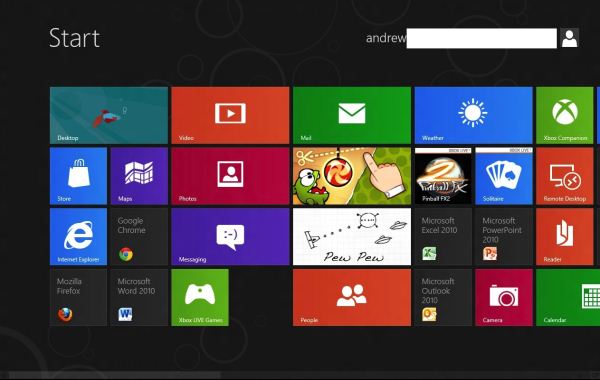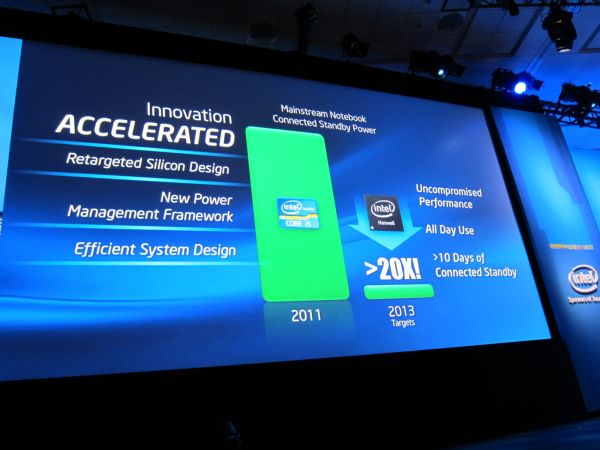The Apple iPad Review (2012)
by Vivek Gowri & Anand Lal Shimpi on March 28, 2012 3:14 PM ESTThe Next iPhone
Historically the iPad has been the launch vehicle for Apple's next-generation iPhone SoC. It's safe to say that the 45nm A5X we've seen here today won't be finding its way into a smartphone. Instead what we're likely to see in the next iPhone this year is a 28/32nm shrink of the A5, coupled with Qualcomm's 28nm MDM9615 instead of the 45nm MDM9600 enabling LTE support.
It'll be next year before we see the introduction of the A6 in the fourth generation iPad, which will likely bring ARM's Cortex A15 to the table as well as Imagination Technologies' PowerVR Series 6 (codename Rogue) GPU. Apple isn't done driving GPU performance. There's still a chance we'd see the introduction of a Cortex A15 based SoC late this year for the new iPhone but I still believe the timing is too aggressive for that to happen.
Haswell
In working on this review, Vivek IMed me and told me the best part of using an iPad instead of a notebook is the battery life. When the battery indicator reads only 20% left, chances are you've still got a good couple of hours of battery life left on the new iPad. On a MacBook Pro? You're lucky if you get half of that.
The question is, must this gap always exist? The MacBook Pro has much more power hungry silicon, and it's running a much more power hungry OS and application set. I won't go too far into this but one of the promises Intel is making with Haswell, its 2013 microprocessor architecture, is for a > 20x decrease in connected standby power. Intel's goal is to be able to deliver an Ultrabook in 2013 that can remain in connected standby (still receiving emails, Twitter updates, push notfications, etc...) for up to 10 days on a single charge.
What about for a lighter, more tablet like usage model? Will Haswell be able to deliver more iPad-like battery life for most tasks, but offer the horsepower and flexibility to run a traditional OS? I'm hearing very exciting things about next year...
Windows 8
A while ago I made a list of the top 10 things I did with my computer. It looked something like this:
Web Browsing
IM
Photo/Video Editing
Excel
Editing Reviews (HTML)
Publishing Reviews (FTP, CMS access)
3D Gaming
Writing
Email
Twitter
Of that list of 10, most of them could be done on a tablet, but only a couple of them delivered a better experience on a tablet than on a desktop/notebook (web browsing and email). You could argue that interacting with Twitter is also better on a tablet as well. Regardless of where you draw the line however, the fact of the matter is that for a user like me I can't replace a notebook with a tablet or vice versa. I need both. I don't like the idea of needing both, I'd rather just have one that could always deliver the best experience possible.

It's this problem I believe Microsoft is trying to address with Windows 8. Put Windows 8 on a convertible or dockable tablet (ala ASUS' Transformer Prime), with x86 hardware, and you've got a very real solution to this problem. When you want a touchscreen tablet, you've got one. When you want a more traditional workhorse notebook, you've got one there as well. I make the x86 reference because that way you don't lose out on compatibility with all of your older desktop apps that you may rely on.
For years Microsoft has failed to deliver a consumer friendly tablet by forcing a desktop UI on it. Its experience with Media Center taught us all that vastly different usage models need different user interfaces. It took Microsoft a long time to realize this, but with Windows 8 I believe it has one solution to the tablet problem. It is ironic/funny/depressing that with Windows 8 Microsoft is simply making the same mistake it made for years with tablets, in reverse. This time around the desktop experience suffers (or at best, just isn't moved forward) in order to focus more on the tablet experience. Sigh, one of these days they'll figure it out.
The point of this sidebar on Windows 8 is to talk about the iOS equivalent. Apple advocated so strongly with the iPhone for the consolidation of devices, I can't help but assume that we'll see a similar move in the MacBook Air/iPad space. iOS is far more multitasking friendly today than it was a couple of years ago. The support for multitasking gestures alone on the iPad is huge. But there clearly has to be more. I don't even know if iOS 6 is really when we'll see this intersection between tablet and ultra portable happen. Like Haswell, this may also be a 2013 thing...











234 Comments
View All Comments
Jamezrp - Wednesday, March 28, 2012 - link
Didn't want to cause Verizon too much trouble? Heh, very funny. I am amazed at how the iPad ends up being an amazingly good Wi-Fi hotspot. It almost seems like business users should opt to get an iPad for that function alone. I know plenty of people who would be happy to keep it in their bag, with the hotspot feature enabled constantly, while travelling about. Even for the price there is nothing even close that can compare.Plus, you know, you get the tablet too.
supertwister - Wednesday, March 28, 2012 - link
"It’s a quantum leap from the noisy, 0.7MP mess that was the iPad 2 camera."Interesting choice of word considering a quantum is the smallest possible division for a quantity...
omion - Wednesday, March 28, 2012 - link
Quantum leap:(n) an abrupt change, sudden increase, or dramatic advance
The phrase comes from the ability of particles to make a sudden jump between two energy levels. It is a leap (of any amount) between two quantization levels, not a leap of the smallest possible amount.
drwho9437 - Wednesday, March 28, 2012 - link
A large fraction of the die doesn't seem to have a known use? Wondering what could be taking up all that area if not GPU, CPU and memory interfaces/caches... Most other I/O would have small footprints...tipoo - Wednesday, March 28, 2012 - link
The 4S had a larger than usual die for its voice cancellation features that were needed to make Siri work well, the iPad does't have that but it does have voice dictation so some space is probably for that.PeteH - Wednesday, March 28, 2012 - link
A big chunk of it is probably the ISP they talked about when the 4S debuted.Lucian Armasu - Wednesday, March 28, 2012 - link
So this is how I assumed. The new iPad is in fact slower than the iPad 2, if games actually start using the 2048x1536 resolution for their apps, which everyone seems to be encouraging them to do. But once they do that the graphics will either look poorer, or they will be slower than they were on the old resolution, even on an iPad 2.Add that to the fact that apps are much bigger in size with the retina resolution, and the CPU is the same as last year. The new display might look great, but it's obvious that the new iPad is absolutely a step-back in terms of performance, whether it's GPU or CPU we're talking about. Hardly worth an upgrade, especially for iPad 2 owners.
xype - Thursday, March 29, 2012 - link
Blah blah blah performance blah not worth it.I don’t give a shit about theoretical performance that I might be getting if DNA folding software was available for tablets. I really, really give a shit about being able to read website and ebook text without my eyes straining after an hour.
One would think that 10 years after "No wireless. Less space than a nomad. Lame." and Apple raking in millions and billions of profit, those Geek Metrics™ that people are so fond of here (nothing wrong with that, it’s interesting stuff!), would be recognized as completely and utterly worthless to the average population. But apparently not.
The iPad was never ment to replace PCs and Consoles as a hardcore gaming device, and it was never ment as a render farm server replacement. It would be really nice if people realized that, at some point. In the next 5 years, perhaps.
tipoo - Thursday, March 29, 2012 - link
It seems a bit like the 3GS-4 transition, it used the same GPU despite higher resolution and so performed worse at native, although in this case the CPU is unchanged and the GPU is "only" 2x better for 4x the pixels. Developers got around that on the 4 by making games for the old resolution and using upscaling mode. I'd imagine they will do the same here once games hit the limits of the GPU at native. Games like Infinity Blade 2 also use separate resolutions for things like the menus vs shadows vs terrain textures.darkcrayon - Thursday, March 29, 2012 - link
I guess if the only thing you bought an iPad for were games, and you could only consider a game to be worthwhile if it were drawn directly at 2048x1536, you'd have a point. But of course the new iPad could play games at the "iPad 2" resolution at much higher detail, or at a slightly resolution with the same detail, etc.It doesn't make sense to say it's a step backward in performance overall- it simply has the option to display much higher resolution graphics that the old model didn't have. The iPad 2 displays 2048 x 1536 text at "0 mhz" so to speak. It's not like you are losing anything by having the option of ultra high resolution if the type of game (or app) can use it within the hardware capabilities.